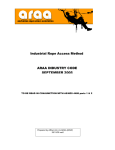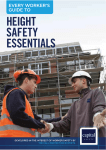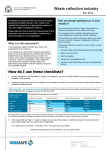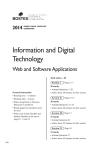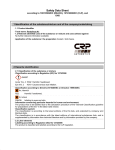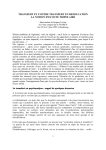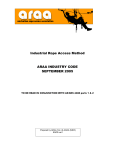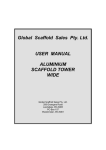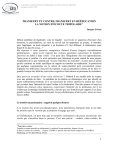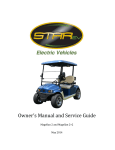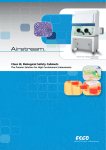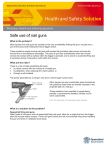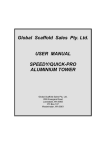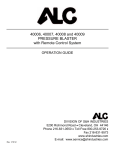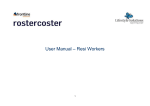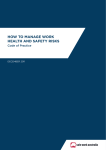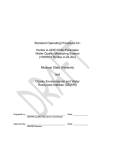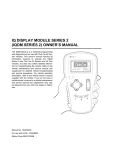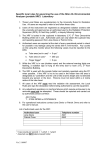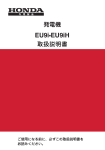Download Safe Working Instruction Guidelines
Transcript
Safe Working Instruction Guidelines Last Update: 23 July 2010 Owner: Manager OHS 1 What are Safe Working Instructions? Safe Working Instructions are written instructions for a process or activity that outlines the recommended safe method of undertaking the process or activity. Written Safe Working Instructions are an essential part of a safe system of work and are an important part of an overall occupational health and safety program. Safe Working Instructions provide information necessary to assist all staff and students to perform tasks safely and reliably. Instructions also assist in the training and orientation of new staff and students in the hazards of the process or activity to be performed. Lastly Safe Working Instructions are a valuable tool in assessing the level of understanding with regards to onthe-job training. The term “Safe Working Instructions” is often used interchangeably with Safe Working Procedures, Safe Work Method Statements and other related terms. In a laboratory they may be collected into a Laboratory Safety Manual. 2 When are Safe Working Instructions necessary? Safe Working Instructions are required for any routine or repeated activity or process that is associated with a medium to high risk. Medium to high risk in this context means any activity or process where an injury may occur if the process is not carried out with care or attention. Where a process or activity is a known cause of injury then Safe Working Instructions are required. 3 Responsibilities The development and implementation (including training) of Safe Working Instructions is the responsibility of the line supervisor or academic-in-charge where students are involved. The Dean, Head of School, Director or unit head is responsible for maintaining a safe system of work that includes Safe Working Instructions. All staff, visitors and students are expected to familiarise themselves with and comply with the Safe Working Instructions that exist in their area of work. Failure to comply with Safe Working Instructions can lead to disciplinary action or withdrawal of rights to carry out work in the area. 4 Developing Working Instructions It is recommended that the preparation of Safe Working Instructions be prioritised as follows: • all new hazardous processes or activities should have Safe Working Instructions prepared before any hazardous process or activity is undertaken • for existing processes, the preparation of Safe Working Instructions should be prioritised according to the level of risk, taking into account hazard exposure, frequency of exposure, and worker knowledge and experience. A higher priority should be placed on the tasks carried out by students. 5 Recommended Compliance Procedure Methodology Step 1: Preparation Resources / Tools Safe Working Instructions must: • be written by a person with sound, hands on experience and knowledge of the activity and process • involve the persons who will be using the Instructions • as far as practicable, involve consultation with the Health and Safety Representative of the area. • involve a review of manufacturer or supplier’s manual or working instructions (where they exist) Safe Working Instruction Guidelines Methodology Page 2 Resources / Tools Step 2. Consider what is needed to be done or available before the task or process is carried out This may include: • the issuing of permits or carrying out isolations • if the work is done by a variety of people, are there any training, licence or skill requirements that need to be checked each time? • the availability of equipment • the use of personal protective equipment Step 3. Observe the task or process Where possible use a third person to observe and record the steps. For a new process, a dry run or trial is often the best way to identify potential problems. For example with a laboratory procedure, observe staff stepping through the process Step 4. Record the sequence of basic job steps A good basis for preparing a Safe Working Instruction is to carry out a Job Safety Assessment, Risk Assessment or Project Safety Plan. • Guidelines for Job Safety Assessments • Job Safety Assessment Template • Safe Working Method Statement Template • Project Safety Plans • Risk Assessments Step 5. Identify and assess potential hazards of each step Step 6. Review associated legislative requirements, standards and University guidelines The Victorian WorkSafe website provides topic based OHS information The OHS website provides guidance on major OHS issues. The Library provides access to Australian Standards Step 7. Assess the risks of the hazards Step 8. Suggest practical ways of eliminating and controlling the hazards See Possible Solutions. If the process or activity remains high risk after applying the control measures discuss the feasibility of the process or activity with the responsible manager. It may be necessary to discontinue/not do the process or activity Step 9. Write up the Working Instructions Use straightforward language: see NSW WorkCover “Writing work method statements in plain English: Guidelines”. Safe Working Instructions (see template) should include: • a description of the activity or process • the person or position that has supervisory responsibility for the activity or process • specific information regarding the hazards and associated risks of the task • precautions to be undertaken before commencing the task • who is authorised or allowed to carry out the work • tools or equipment used in the process • personal protective equipment to be worn while undertaking the task • the environment where the task should be undertaken • clear instructions for undertaking the task described in a safe manner • specific instructions regarding ways of minimising the risks of the task • instructions to ensure that the area is left safe for others to use • correct waste disposal guidelines. Step 10. Test the Instructions by consultation and verify relevant issues are documented With a new process or a changed one, where possible a dry run or trial is often the best way to identify potential problems. For example with a laboratory procedure observe staff stepping through the new Instruction Safe Working Instruction Guidelines Methodology Page 3 Resources / Tools Step 11. Obtain approval of the Instructions from a supervisor or manager. When complete, Safe Working Instructions should be reviewed, signed and dated by the area supervisor and if there is one, the local safety officer. Step 12. Ensure the new or revised Instructions are available to staff and students that may need them Safe Working Instructions should be displayed prominently or readily available in the areas in which they are to be used: Step 13. Carry out any necessary training or familiarisations. The supervisor should verify that the Instructions are being followed and are workable. 6 For equipment and machinery: • Safe Working Instructions for each piece of equipment/ machinery should be displayed prominently close to the location of the equipment/machinery • the manufacturer's user manual provided with the equipment/machinery is a good resource for safety information to include in Safe Working Instructions. Examples Examples of Standard Safe Working Instructions can be found at: • Monash University: Workshop machinery equipment and process ESWI’s • WorkSafe Victoria • RMIT: Safe Work Instructions (machinery and plant) • University of New South Wales: Safe Work Procedures for the Office • SafetyCulture: Safe Work Method Statements (a wide range of examples) • Canadian Centre for Occupational health and Safety: Safety Hazards (a wide range of examples) • NSW WorkCover :Writing work method statements in plain English 7 Review and Evaluation Safe Working Instructions are required to be reviewed: • whenever the task or activity changes • when a new hazard is identified or becomes known: for example, new information in a Material Safety Data Sheet. • when equipment or processes are not used for a period of time (over 6 months) and worker knowledge and experience declines • after an associated injury, near miss or illness • every three years. Safe Working Instruction Guidelines Page 4 POSSIBLE SOLUTIONS TO PREVENT OR REDUCE THE LIKELIHOOD OF INJURIES (in order of preference: 1 is a better solution than 2 etc). Working Environment 1. Install ventilation extraction systems in hot work areas. 2. Fit localised lighting on machines to enable operators to comfortably view work pieces. 3. Suspend electrical power lines and air lines. 4. Round-off edges and corners of benches, equipment or fittings. 5. Install safety barriers to protect pedestrians from vehicles or mobile plant. 6. Install mirrors and flashing lights to warn of approaching vehicles or mobile plant. 7. Fit reverse warning beepers and lights to mobile plant for example, forklifts. 8. Install hand rails on ramps and steps. 9. Install non-slip floor surfaces. 10. Install good lighting along walkways. 11. Removing overhanging objects from work areas. 12. Provide fixed plant and machinery with drip trays. 13. Supply cool water for workers required to work in hot areas. 14. Regularly sweep and clean floors. 15. Keep walkways and work areas uncluttered. 16. Identify walkways with painted yellow lines. 17. Have available temporary signs to warn of slippery surfaces. 18. Introduce job rotation and frequent rest breaks for jobs which could cause workers to suffer from the extremes of hot or cold. 19. Provide workers with a variety of tasks. 20. Introduce job rotation for jobs which may be fatiguing. 21. Provide personal protective clothing and footwear to minimise the effects of cold. Plant or Machinery 1. Enclose very noisy plant or machinery in sound-proof barriers or relocate in separate area from the majority of workers. 2. Guard moving parts of the plant or machinery (fixed or adjustable guards, photo-electric, pressure sensing mats). 3. Interlock guards with power supply (power supply is automatically switched off when guard is opened or removed). 4. Make guards difficult to remove or machinery difficult to disable. 5. Install two – hand controls. 6. Provide feeder tables or rollers. 7. Use clamps, supports, guides or stops to position workpieces. 8. Fit lock out switches to all plant and machinery to disconnect power supply while being cleaned, serviced or repaired. 9. Guard or shield hot or cold machine components from accidental contact. 10. Fit emergency stops to plant and machinery which is easy to see, operate and reach at all times. 11. Make sure plant or machine controls are easy for the operator to understand and reach. 12. Introduce lock-out procedures and provide locks and tags. 13. Write safe operating procedures for all machinery operations. 14. Clearly identify with warning signs and line marking areas where hot processes are carried out. 15. Provide workers likely to be burnt by hot material with personal protective equipment such as gauntlets, aprons, face shields. 16. Provide workers with good quality hearing protection. Manual Handling 1. Reduce the weight of the object to be lifted or carried; for example, smaller containers or less material per container. 2. Make sure containers are easy to lift or carry; for example, they are provided with handles or grips, or are a comfortable shape and size. 3. Change the height of workbenches or shelving to reduce the need to bend or overreach. 4. Provide equipment to assist with the lifting carrying or moving; for example, hoists, trolleys, scissor lifts, conveyors. 5. Make sure tools or equipment are comfortable and easy to lift, use or operate. 6. Suspend heavy tools or equipment. 7. Provide footrests, comfortable and adjustable seating and cushioned floor coverings. 8. Reduce the distance to carry objects. 9. Change the work process so that objects do not have to be lifted or moved as often by hand. 10. Introduce job rotation with a mixture of repetitive and non – repetitive tasks. 11. Provide training in safe manual handling. 12. Make sure there is a two – person lift. 13. Provide frequent short rest breaks for workers carrying out repetitive tasks. Tools or Equipment 1. Make sure tools or equipment with rotating or moving blades or cutters are fitted with guards. 2. Make sure electrically powered equipment is only used if protected by a safety switch (Residual Current Device). 3. Provide industrially insulated power extension cords. 4. Prevent mobile plant or vehicles driving over power cords. 5. Regularly test and tag electrically powered equipment. 6. Write safe operating procedures for all powered tools and equipment. 7. Train workers on the safe use of tools and equipment. 8. Introduce job rotation and frequent rest breaks for jobs which involve the risk of injury from mechanical vibration. 9. Provide safety glasses or face shields. 10. Provide workers with good quality hearing protection. 11. Provide workers likely to be burnt by hot material with personal protective equipment such as gauntlets, aprons, face shields. Chemicals or Substances 1. Use less dangerous chemicals or substances. 2. Use paste or pellets instead of powders. 3. Apply paint by brush instead of spraying. 4. Store chemicals in sealed containers. 5. Install an extraction system to remove fumes vapours or dust. 6. Obtain Material Safety Data Sheets for all chemicals or substances. Particularly Hazardous Substances and Dangerous Goods. 7. Follow safety precautions contained in Material Safety Data Sheets. 8. Make sure all containers are labelled. 9. Write safe operating procedures for the handling or use of chemicals or substances. 10. Train workers on the safe handling or use of chemicals or substances. 11. Provide first aid, safety showers, eye wash. 12. Provide proper personal protective equipment such as gloves, aprons, cartridge respirators, safety glasses and face shields. Safe Working Instruction Guidelines Page 5 Template: SAFE WORKING INSTRUCTIONS for [TITLE OF EQUIPMENT/MACHINERY/ACTIVITY/TECHNIQUE/PROCESS] 1. Description of the Activity 2. Supervisor 3. Job Safety Assessment Is a Job Safety Assessment required before the work is carried? (or in some circumstances) 4. Authorisation With especially laboratory or workshop processes, it is vital to clearly identify who can do this work. 5. Hazards associated with equipment /machinery /technique /process For example: • Hazardous chemicals/radiation/biological materials, sharps to be used, high voltage, swarf produced, speed of operation, possibility of infection/allergy. 6. Before Starting For example: • Permits required to undertake technique/process or use equipment/machinery • If required, procedures and personnel that provide authorisation • Are isolations required? • Training/supervision/licences/skills required for task • Vaccinations, antidotes or other precautions • Specific requirements to perform activities, for example after hours ( prohibit activity, two people in room, buddy system, etc.) or with student use • Location of further information about the hazards, e.g. material safety data sheets, radiation safety manual, laboratory safety manual • Preparation of area, materials, person required before commencing task 7. Tools and equipment For example: • Fume cupboard, glove box, local exhaust ventilation, biosafety cabinet, radiation laboratory. 8. Personal protective equipment to be used For example: • Safety glasses/goggles/face shield; protective shoes/rubber boots/waders; gloves; laboratory coat/back-opening gown; safety helmet/hair fasteners/net; ear plugs/muffs; respiratory protection 9. Emergency procedures If an accident or other unexpected event occurs, what are the emergency procedures to get first aid, to shut down processes. Who should be notified? 10. Step by step procedures for task (include all routine steps including set up and close down) Step 1. …………………. 11. Clean-up procedures For example: • Swarf removal, decontamination of glassware, cleaning of benches, storage of used materials, carcass removal. 12. Waste disposal procedures For example: • For chemical/biohazardous/radioactive waste, broken glassware, wood dust, rags 13. Record keeping • 14. Prepared by, and Date: Approved by, and Date: What routine records need to be kept? (maintenance, production) and how should they be kept, who is responsible, what should be done with them (stored), should they be reviewed by someone else?





